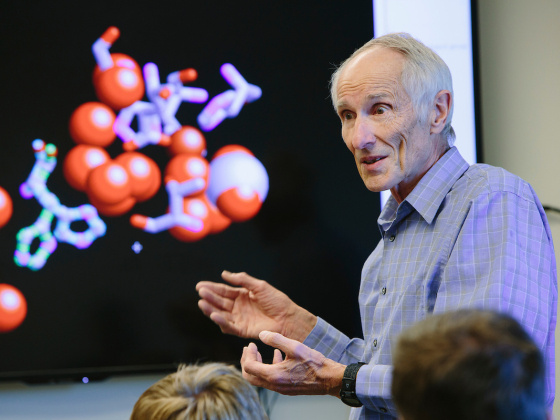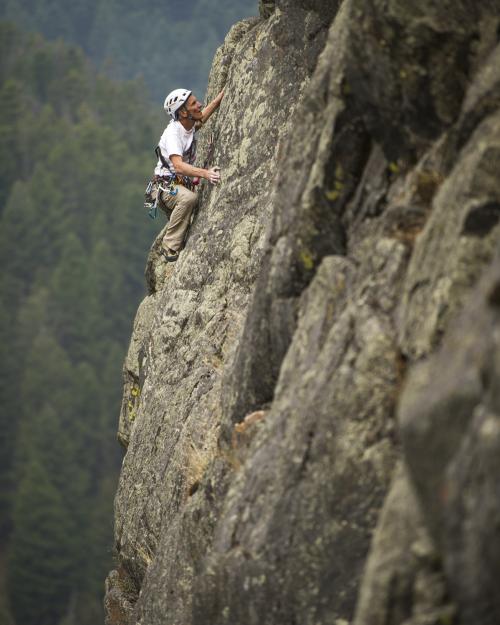BOZEMAN – In 2006, Patrik Callis predicted in an interview that his retirement from Montana State University would unfold somewhat gradually. He began the process two years later, but didn’t complete it until this fall, 56 years after joining the faculty of the Department of Chemistry and Biochemistry and surpassing the record as the longest-tenured professor in MSU’s history.
That distinction is one of many that the 86-year-old scientist and climber has achieved during a lifetime that has been shaped, he said, by epiphany and serendipity. Some events led him to paths forged in research, and others to adventurous routes he pioneered on first ascents of legendary pinnacles of the American West. He has befriended giants among mountaineers and academics, enjoying prominence among them while remaining “one of the nicest, most generous people you’ll ever meet,” according to MSU chemistry professor and longtime colleague Rob Walker.
For Callis, retirement represents a milepost along a continuing journey rather than the end of the road.
“I never wanted to retire, really,” he said on a recent, snowy morning, before heading to a local climbing gym for his weekly workout and keeping an eye on his watch so he wouldn’t be late for guests he was expecting later in the day. “I much preferred continuing what I was doing compared to staying at home and doing nothing, but 20 years extra was enough.”
Now that he’s officially retired, Callis has no intention of settling into “doing nothing.” He continues research into “the secret of enzymes” while working with a former student to prepare related scientific papers for publication. As winter approaches, he is excited to get back to climbing the famous Hyalite Canyon icefalls near Bozeman that he was the first to discover—by luck, he believes—during a cross-country ski outing in 1970. To stay in shape for climbs in all seasons, Callis runs every day on trails near his home.
“I’m not doing long runs while I’m finishing writing these papers,” he said of his continuing academic work. “I’ve got to get that done before I can have the luxury of going up (Mount) Baldy again.”
The papers describe what has been discovered during the enzyme research he hopes to be remembered for. He said the idea for the research came unexpectedly several years ago. Mary Cloninger, professor and then-head of MSU’s Department of Chemistry and Biochemistry, remembers the day Callis told her he wanted to make that pivot in his research.
“Well past the time that most people retire, he had this fantastic idea for beautiful, creative research,” she said. “He asked me if I thought it was too late, and I said, ‘Absolutely not. Why don’t you go work on that?’”
By that time, Callis had spent decades amassing expertise in photophysics, the study of how light interacts with matter. His research interests developed at the University of Washington during his first year of doctoral study, when he met a quantum theoretician whose team was studying the building blocks of DNA in hopes of discovering the genetic code.
“That was an epiphany,” Callis recalled. “My mind was enormously expanded by the insight that physical chemistry had the potential to understand the origin of life.”
From then on, Callis has worked in the interface between physical and biological chemistry to further human understanding of fundamental science. His expertise has benefited all types of students.
“He understands physical chemistry at a level that’s well beyond what most people will ever be able to access, and he also understands how it applies to biochemical systems in a way that’s just so valuable,” Cloninger said, adding that he was able to teach both physical and biochemistry concepts effectively. “A lot of people can work well on one side or the other, but to be able to do both is quite rare and very special.”
After his postdoctoral work at Caltech, Callis joined the MSU faculty in 1968. The department needed a professor of quantum chemistry, a field that attracted Callis because, he said, it “explains the world’s behavior, especially electrons and atoms, at the most fine-grained level.” He was recommended for the job by MSU chemistry professor Ed Anacker, who had met Callis at a conference where the two discovered their common interest in rock-climbing.
“I had a fantastic, enjoyable interview,” said Callis, recounting that he was impressed by the department’s quality, research, excitement and friendliness. For the adventurous skier and climber, Bozeman’s environs were attractive, too.
“It seemed like a great place and a perfect fit for me,” Callis said. “I never have regretted it, and I never wanted to go anywhere else.”
By all accounts, Callis’ steady presence at MSU tremendously benefited the department, his colleagues and his students.
“His talent in the chemistry arena is maybe less visible for the community because you’re impacting students’ lives rather than saving the lives of people lost in the wilderness,” said Cloninger, noting that Callis’ renown in the climbing world extends to heroism as a search and rescue volunteer. “What people in the outside world don’t realize is he’s as gifted in his profession as he is in the outdoors. Yes, he is a talented outdoorsman, but wow, was he a talented professor.”
In both arenas, according to Walker, Callis exhibits fearlessness.
“It is easier to start a line of inquiry or build a research program if one uses routine, low-level methods to study very complicated phenomena. Alternatively, one can develop very sophisticated measurement techniques to look at rather simple systems. Pat did both,” Walker said. “He identified a challenge that was both difficult and without well-defined pathways to that would lead to solutions and said, ‘I’m going to do what’s necessary to learn.’ That attitude is fearless. Pat’s work that started in the 1980’s was a high-risk, high-reward undertaking, and it paid off.”
Callis credits a sabbatical at Cornell University during the 1979-80 academic year with sparking his idea for that research on the computational molecular dynamics of DNA and proteins. The foray into theoretical and computational research ultimately led him to take the first step toward his gradual retirement in 2008, when the department relocated from Gaines Hall to the new Chemistry and Biochemistry Building. Callis chose not to move his physical lab into space which he said could be used by younger professors, a decision he describes as painful but in the best interest of the department.
Cloninger said that choice was just one example of Callis’ consideration for others.
“The thing to really emphasize is just how supportive he is,” she said, citing a half-dozen additional examples of Callis’ willingness to always be of service to the department. “If he was in an area where he could help, he would put that first and foremost.”
Callis has been recognized again and again for his teaching. In 2018 he was named a Montana University System Regents Professor, the most prestigious designation the system bestows. Cloninger and Walker relayed numerous examples of his commitment to students, which included his choice to mentor undergraduates in research once he stopped taking graduate students 12 years ago.
MSU alumnus Max Yates, now a medical student at Harvard, was one of the undergraduates who joined Callis’ lab as a freshman. He remembers his professor as an excellent classroom teacher who brought “enthusiasm and joy to chemistry” and as a kind, patient and selfless mentor.
He said he was nervous when it came time to tell his mentor that he wanted to pursue a vocation in medicine instead of chemistry, but that Callis “was nothing but supportive. He was always very invested in what was best for me.”
Pedro Muíño, a former student and now research collaborator who is a professor and chair of the Department of Chemistry at Saint Francis University in Pennsylvania, echoed those sentiments.
“I always felt that I had somebody who cared about me for more than the value I could add to the lab,” said Muíño, who first met Callis in the 1980s as an undergraduate exchange student from Spain and later returned to Bozeman to pursue his Ph.D. “I have never doubted that my decision was the best one: Going to Montana State and working for Pat Callis.”
Added Yates, “I think I would speak on behalf of every student who has crossed paths with Pat—to send him a big congratulations and gratefulness that he was such a wonderful mentor. A lot of students’ lives were made better because of him.”






